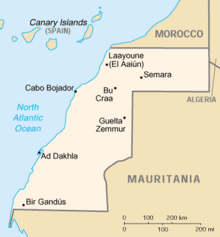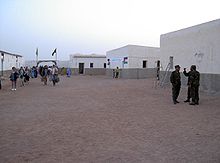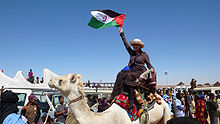- Free Zone (region)
-
Main article: Western Sahara
Part of a series on the History of Western Sahara 
Background History of Morocco (Colonial wars)
Spanish Sahara · Spanish Morocco
Moroccan Army of Liberation
Harakat Tahrir · Sahrawi National Union Party
Madrid AccordsDisputed regions Saguia el-Hamra · Río de Oro
Southern Provinces · Free Zone ·Politics Legal status of Western Sahara · Politics of Morocco / of the SADR
Polisario Front (former members)
Royal Advisory Council for Saharan AffairsRebellions Pre-1975:
Ifni War · Zemla Intifada
post 1975:
Western Sahara War · Independence IntifadaConflict issues Refugee camps · Wall · Human rights in Western Sahara Sahara peace process Resolution 1495 · Resolution 1754 · Visiting mission · Referendum mission · ICJ Advisory Opinion · Settlement Plan · Houston Agreement · Baker Plan · Manhasset negotiations · Moroccan Initiative Sahrawi Arab Democratic Republic 
This article is part of the series:
Politics and government of
the Sahrawi Arab Democratic Republic- Constitution
- President
- Prime Minister
- Abdelkader Taleb Omar
- National Council
- Speaker
- Kathri Aduh
- Speaker
- Political parties
- Elections: 2008
- Foreign relations
- Free Zone
The Free Zone or Liberated Territories is a term used by the Polisario Front to describe the part of Western Sahara that lies to the east of the Moroccan Berm (the Moroccan border wall) and west and north of the borders with Algeria and Mauritania, respectively. The area is separated from the rest of the Western Sahara territory by "a 2,200 kilometer [1,367 mi]-long wall...flanked by one of the world's largest minefields."[1] The border is often referred to simply as the "Berm."
The zone was established as a POLISARIO-held zone in a 1991 cease-fire between the Polisario Front and Morocco, which had been agreed upon together as part of the Settlement Plan. Morocco controls the areas west of the Berm, including most of the territory's population. The cease-fire is overseen by the United Nations' MINURSO forces, charged with peacekeeping in the area and the organization of a referendum on independence.[2]
Contents
Status and Military Agreement
 The Berm follows the line between the grey and yellow areas.
The Berm follows the line between the grey and yellow areas.
The status of Western Sahara is hotly disputed between Polisario and Morocco, and this includes the titles used to refer to areas under the control of the different sides.
Morocco routinely refers to the Polisario-held region as a "buffer zone", or "buffer strip", and claims that Polisario forces are not allowed entry, and that both military activities and civilian construction in this area constitute violations of their cease-fire agreement.[3][4] But this does not correspond to the provisions of the agreement regulating the territory's status, which Morocco signed in 1991, because the "buffer strip" is only a slim portion of the entire territory. This zone serves as a division-of-forces no mans land. Areas outside this zone are open to activity by the side that controls them, provided they adhere to some restrictions on military movements. Similarly, Polisario call the areas a "liberated territory" or the "free zone", but this is not an official designation. The UN calls it simply "east of the Berm", and refers to territories under Moroccan control as "west of the Berm", thus not giving sanction to the claims of either party.
According to the Settlement Plan, the movement of Polisario fighters is restricted similarly to how Moroccan forces face restrictions on their side of the Berm. The MINURSO details details the following restrictions for the different zones:
-
- One 5 kilometres (3 mi) wide Buffer Strip (BS) to the South and East side of the Berm;
-
- Two 30 kilometres (19 mi) wide Restricted Areas (RA) along the Berm. The Buffer Strip is included in the Restricted Area on the POLISARIO side and the Berm is included in the Restricted Area on the RMA side;
-
- Two Areas with Limited Restrictions (ALR), which are the two remaining vast, stretches of land of Western Sahara on both sides respectively.
- Each of the five parts has specific restrictions as for the two parties’ military activities:
-
- Buffer Strip: No entry of RMA and FPOL personnel and equipment, by ground or air. No firing of weapons in or over the area.
-
- Restricted Areas: No firing of weapons and/or military training exercises, with the exception of physical training activities of unarmed personnel. No tactical reinforcements, no redeployment or movement of troops, headquarters/units, stores, equipment, ammunition, weapons, no entry of military aircraft and no improvements of defence infrastructures. Some exceptions apply and some activities are allowed after prior information to or approval by MINURSO (Note: these are restrictions in brief, for detailed information please read the MA#1 in full).
-
- Areas with Limited Restrictions: All normal military activities can be carried out, except the reinforcement of existing minefields, the laying of mines, the concentration of forces, the construction of new headquarters, barracks and ammunition storage facilities. MINURSO need to be informed if the parties intend to conduct military exercises, including the firing of weapons of a calibre above 9mm.
Population and activities in the area
Access is difficult even for Sahrawis due to the harsh climate of the Sahara, the military conflict and the abundance of land mines.[5] The area is inhabited primarily by Sahrawi nomads, that maintain the traditional camel herding of their ancestors, between the zone, northern Mauritania and the refugee camps. There is also a small merchant population, who sell goods to travellers. The population of the territory is estimated between 30,000[1] -40,000[6] inhabitants. The major settlements on the zone are Tifariti, Bir Lehlou, Agounit, Meharrize, Mijek, Dougaj and Zug.
Major Sahrawi political events, such as Polisario congresses and opening sessions of the Sahrawi National Council (the SADR parliament in exile) are held in the zone (especially in Tifariti and Bir Lehlou), since it is considered socially, politically and symbolically important to conduct political affairs on Sahrawi land.
Polisario Force strength
The Polisario troops (of the Sahrawi People's Liberation Army, SPLA) in the area are divided into seven "military regions", each controlled by a top commander reporting to the President of the Polisario proclaimed Sahrawi Arab Democratic Republic.[7] The total size of the Polisario's guerrilla army present in this area is unknown. Some sources claim between 3,000-6,000 men,[8] while others rise the number up to 12,000,[9] with additional combantants stationed in Algeria, Mauritania or having been demobilized due to the cease-fire. These forces are dug into permanent positions, such as gun emplacements, defensive trenches and underground military bases, as well as conducting mobile patrols of the territory.[10]
Incidents in the area
A concentration of forces for the commemoration of the Saharawi Republic's 30th anniversary[11] were however subject to reproach by the United Nations,[12] as it was considered an example of a cease-fire violation to bring such a large force concentration into the area.
Minurso reports that there are on average 2-4 such violations in the whole Western Sahara territory each month, between the two sides. In addition to this, there are several more violations related to local commanders on both sides refusing the inspection of their forces by Minurso personnel. As an example, the mission homepage quotes the month of June 2006, when there were "189 such FMO [freedom of movement]-violations, all related to the denial of UNMO [UN military officers] entry into the parties’ strong-points and units."[3] Despite these minor breaches, there has to date been no serious hostile action from either side since 1991, and both sides of the Berm are considered calm by peacekeeping standards.
Annual demonstrations against the Moroccan Wall are staged in the region by Sahrawis and international activists from Spain, Italy and other mainly European countries. These actions are closely monitored by the UN.[13]
 Tifariti, in the northeast of the zone, 2005
Tifariti, in the northeast of the zone, 2005
See also
References
- ^ a b http://www.nrc.no/arch/_img/9258989.pdf Norwegian Refugee Council Report: Western Sahara, Occupied country, displaced people, 2008
- ^ http://www.un.org/Depts/dpko/missions/minurso/ MINURSO homepage Accessed May 21, 2006
- ^ [1]
- ^ [2]
- ^ Landmine Action UK, "Explosive Ordenance Disposal and technical survey in Polisario-controlled areas of Western Sahara," Project proposal, February 2006, p. 2 - 4, quoted in Land Mine Report, Western Sahara, http://www.icbl.org/lm/2006/western_sahara.html#fn16, footnote 15 and 17
- ^ Vivir sin nubes El País, December 18, 2010(Spanish)
- ^
- http://www.arso.org/bhatia2001.htm Western Sahara under Polisario Control: Summary Report of Field Mission to the Sahrawi Refugee Camps (near Tindouf, Algeria) by Michael Bhatia, 2001
- http://www.newint.org/issue297/wall.html "Up Against the Wall", Chris Brazier, New Internationalist Magazine (297), December 1998
- http://www.palinstravels.co.uk/book-2056 Michael Palin, "Sahara with Michael Palin" ISBN 0-297-84303-6, 2002
- ^ http://www.arso.org/bhatia2001.htm Western Sahara under Polisario Control: Summary Report of Field Mission to the Sahrawi Refugee Camps (near Tindouf, Algeria) by Michael Bhatia, 2001
- ^ MINURSO United Nations mission for the referendum in Western Sahara - 1991 to today
- ^
- http://www.palinstravels.co.uk/photogallery.php?offset=10&photobook=1&series=12 Michael Palin, "Sahara with Michael Palin" ISBN 0-297-84303-6, 2002
- http://www.guardian.co.uk/Archive/Article/0,4273,4132213,00.html "Saharan rebels stranded in camps, casualties of the stalemate between Morocco and the Algerian-backed Polisario rebels; 100,000 refugees subsist on aid." by Rory Carroll in Tifarity, Guardian, Wednesday February 7, 2001
- http://www.newint.org/issue297/wall.html New Internationalist, Chris Brazier, "Up Against the Wall", New Internationalist Magazine (297), December 1998* http://www.tobysavage.co.uk/Article%20texts/4x4%20mag%20WS%20article.html
- http://www.palinstravels.co.uk/book-2056 Michael Palin, "Sahara with Michael Palin" ISBN 0-297-84303-6, 2002
- ^ http://www.spsrasd.info/sps-e270206.html Commemoration of the Saharawi Republic's 30th anniversary in liberated territories of Western Sahara Sahara Press Service, February 27, 2006
- ^ http://daccessdds.un.org/doc/UNDOC/GEN/N06/310/51/PDF/N0631051.pdf?OpenElement Secretary General's report to Security Council on Western Sahara, 19 April 2006
- ^ http://daccessdds.un.org/doc/UNDOC/GEN/N06/310/51/PDF/N0631051.pdf?OpenElement Secretary General's report to Security Council on Western Sahara, 19 April 2006 (pdf file)
External links
- United Nations (Map) Minurso Deployment as of October 2006, Map No. 3691 Rev. 53 United Nations, October 2006 (Colour), Department of Peacekeeping Operations, Cartographic Section
Coordinates: 23°20′56″N 12°55′59″W / 23.349°N 12.933°W
Sovereign
states- Algeria
- Angola
- Benin
- Botswana
- Burkina Faso
- Burundi
- Cameroon
- Cape Verde
- Central African Republic
- Chad
- Comoros
- Democratic Republic of the Congo
- Republic of the Congo
- Côte d'Ivoire (Ivory Coast)
- Djibouti
- Egypt
- Equatorial Guinea
- Eritrea
- Ethiopia
- Gabon
- The Gambia
- Ghana
- Guinea
- Guinea-Bissau
- Kenya
- Lesotho
- Liberia
- Libya
- Madagascar
- Malawi
- Mali
- Mauritania
- Mauritius
- Morocco
- Mozambique
- Namibia
- Niger
- Nigeria
- Rwanda
- São Tomé and Príncipe
- Senegal
- Seychelles
- Sierra Leone
- Somalia
- South Africa
- South Sudan
- Sudan
- Swaziland
- Tanzania
- Togo
- Tunisia
- Uganda
- Zambia
- Zimbabwe
States with limited
recognition- Sahrawi Arab Democratic Republic
- Somaliland
Dependencies and
other territories- Canary Islands / Ceuta / Melilla / Plazas de soberanía (Spain)
- Madeira (Portugal)
- Mayotte / Réunion (France)
- Saint Helena / Ascension Island / Tristan da Cunha (United Kingdom)
- Western Sahara
Categories:- Sahrawi Arab Democratic Republic
- Geography of Western Sahara
- Secession in Morocco
Wikimedia Foundation. 2010.

